Stretch of wall in ancient Jerusalem vindicates the holy book’s account
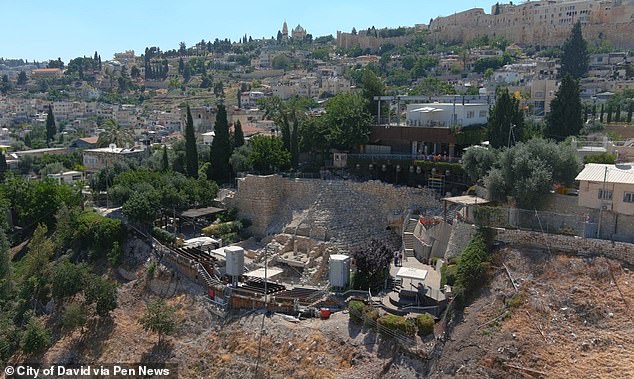
The stretch of wall, at the eastern slopes of the City of David, was long assumed to be built by Hezekiah, King of Judah
A scientific breakthrough has exposed the truth about a site in ancient Jerusalem, overturning expert opinion and vindicating the Bible’s account.
Until now, experts believed a stretch of wall in the original heart of the city was built by Hezekiah, King of Judah, whose reign straddled the seventh and eighth centuries BC.
He had seen his neighbours to the north, the Kingdom of Israel, destroyed by the Assyrian Empire, and it was thought that he built the wall to defend against the invaders.
But now an almost decade-long study has revealed it was built by his great-grandfather, Uzziah, after a huge earthquake, echoing the account of the Bible.
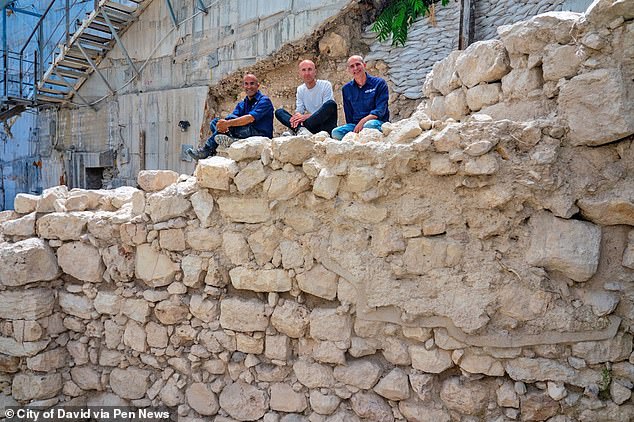
An almost decade-long study has revealed it was built by his great-grandfather, Uzziah, after a huge earthquake, echoing the account of the Bible
The wall is in the City of David – the historic archaeological site that formed the original town of Jerusalem, according to the Bible.
 Joe Uziel of the Israel Antiquities Authority (IAA) said: ‘For decades, it was assumed that this wall was built by Hezekiah, King of Judah.
Joe Uziel of the Israel Antiquities Authority (IAA) said: ‘For decades, it was assumed that this wall was built by Hezekiah, King of Judah.
‘But it is now becoming clear that it dates back to the days of King Uzziah, as hinted at in the Bible.
‘Until now, many researchers assumed that the wall was built by Hezekiah during his rebellion against Sennacherib, King of Assyria, in order to defend Jerusalem during the Assyrian siege.
‘It is now apparent that the wall in its eastern part, in the area of the City of David, was built earlier, shortly after the great earthquake of Jerusalem, and as part of the construction of the city.’
The Old Testament describes the construction in the Second Book of Chronicles.
It reads: ‘Uzziah built towers in Jerusalem at the Corner Gate, at the Valley Gate and at the angle of the wall, and he fortified them.’
Scripture also attests to the seismic activity – with the Old-Testament Book of Amos dating itself to ‘two years before the earthquake, when Uzziah was king of Judah’.
The study, a joint project between the IAA, Tel Aviv University, and the Weizmann Institute of Science, revealed the provenance of the ancient wall using carbon-14 dating.
Also known as radiocarbon dating, this technique uses the decay of a radioactive isotope of carbon (14C) to measure the time and date objects containing carbon-bearing material.
According to the IAA, this period of history was previously considered a ‘black hole’ for carbon-14 dating, due to fluctuating levels of the isotope in the atmosphere at the time.

Until now, experts believed a stretch of wall in the original heart of the city was built by Hezekiah, King of Judah (left). But the study has revealed it was built by his great-grandfather, Uzziah (left) after a huge earthquake
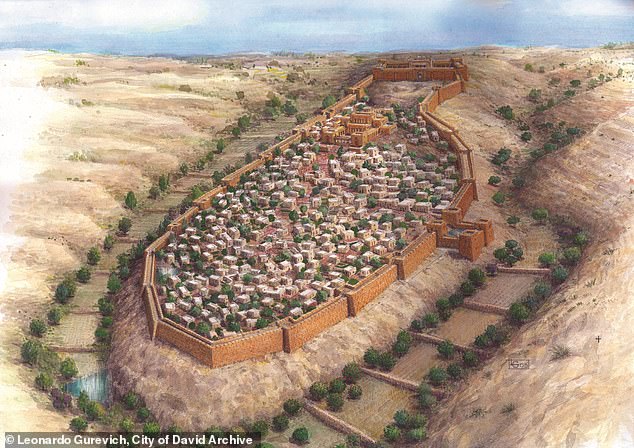
Illustration of the the First Temple Period city fortification built in the days of King Uzziah, around 783 to 742 BC
But using ancient tree rings from Europe, scientists were able to chart these fluctuations year by year.
Elisabetta Boaretto of the Weizmann Institute said: ‘The resolution of c-14 was very bad – 200-300 years; it was impossible to distinguish anything else.
‘With the work we’ve done in the City of David, we succeeded to reach a resolution less than 10 years, which is really something very very new and dramatic.’

Pictured, Dr Joe Uziel of the Israel Antiquities Authority (left) and Professor Yuval Gadot of Tel Aviv University
The scientists took their samples from organic artifacts found at four different excavation sites in the ancient heart of Jerusalem – sometimes called the City of David.
Among these were grape seeds, date pits and even bat skeletons.
All were cleaned, converted into graphite, then put into a particle accelerator at speeds of 3,000km per second to separate the carbon-14 from other organic material.
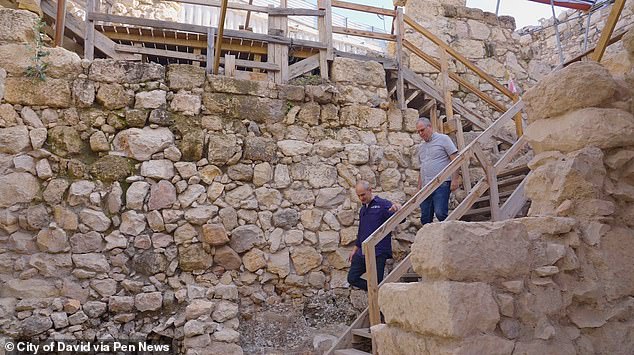
The city wall unearthed in the City of David was not built during the days of Hezekiah as part of the preparations for the Assyrian siege, but rather earlier, during the days of King Uzziah, subsequent to the earthquake that occurred in Jerusalem
Measuring the carbon then revealed the sample’s true age.
Yuval Gadot of Tel Aviv University said the method had also pushed back the westward expansion of the city by five generations.

The wall is in the City of David – the historic archaeological site that formed the original town of Jerusalem, according to the Bible
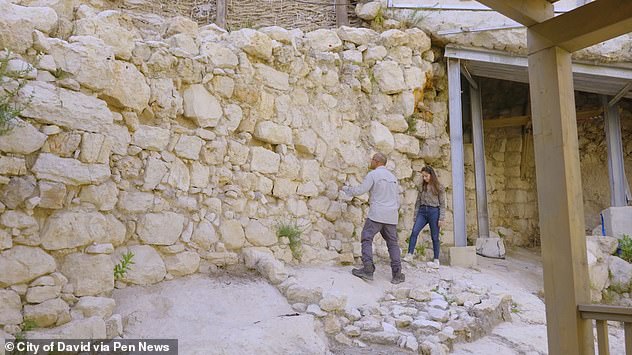
Researchers have succeeded in using ‘exact science’ to link events mentioned in the Bible to archaeological findings unearthed in the city of David
He said: ‘Until now, most researchers have linked Jerusalem’s growth to the west, to the period of King Hezekiah – just over 2,700 years ago.
‘The conventional assumption to date has been that the city expanded due to the arrival of refugees from the Kingdom of Israel in the north, following the Assyrian exile.
‘However, the new findings strengthen the view that Jerusalem grew in size and spread towards Mount Zion already in the ninth century BC.
‘This was during the reign of King Jehoash – a hundred years before the Assyrian exile.
‘In light of this, the new research teaches that the expansion of Jerusalem is a result of internal-Judean demographic growth and the establishment of political and economic systems.’
What’s more, it shows that the city was larger than thought during the reigns David and Solomon.
Dr Uziel said: ‘During the 10th century BC, the days of David and Solomon, this research has shown that the city is occupied in different areas, and seems to have been larger than we thought previously.
‘We can pinpoint specific buildings and relate them to specific kings mentioned in the Biblical text.’
The Kingdom of Judah would last until 587 BC, when the Babylonians besieged and destroyed its capital Jerusalem, along with Solomon’s Temple – often called the First Temple.
Has the Kingdom of King David Been Found?
Archaeologist claims five fortified cities near Jerusalem were ruled by the Biblical figure in 1000 BC
 An archaeologist claims the ruins of five fortified cities outside of Jerusalem belonged to the same kingdom ruled by the Biblical figure King David.
An archaeologist claims the ruins of five fortified cities outside of Jerusalem belonged to the same kingdom ruled by the Biblical figure King David.
Yosef Garfinkle with the Hebrew University of Jerusalem believes the cities date to the early 10th century BC, some 200 years than previously thought, placing their construction in the time of David.
Garfinkel’s study, published in June, describes the cities all featuring two parallel walls in the center and organized roads, suggesting the network was connected to one kingdom.
While the cities were discovered separately, the archaeologist claims he is the first to connect the dots – determining they are an organized urban network built around 1000 BC.
And King David ruled from 1104 to 960 BC during the Iron Age.
David is said to have been a shepherd boy who became Israel’s third and most crucial king around 1000 BC when he united all the tribes of Israel under a single monarch – but the story has been disputed due to a lack of evidence. (Continue reading…)
Written by Michael Havis for the Daily Mail ~ May 3, 2024
